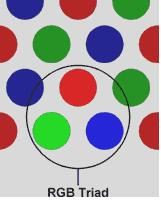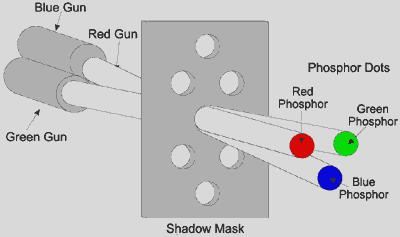In Shadow Mask CRT tiny holes in a metal plate separate the colored phosphors in the layer behind the front glass of the screen. The holes are placed in a manner ensuring that electrons from each of the tube’s three cathode guns reach only the appropriately-colored phosphors on the display. All three beams pass through the same holes in the mask, but the angle of approach is different for each gun.
The spacing of the holes, the spacing of the phosphors, and the placement of the guns is arranged so that for example the blue gun only has an unobstructed path to blue phosphors. The red, green, and blue phosphors for each pixel are generally arranged in a triangular shape (sometimes called a “triad”). All early color televisions and the majority of computer monitors, past and present, use shadow mask technology.
Traditionally, shadow masks have been made of materials which temperature variations cause to expand and contract to the point of affecting performance. The energy the shadow mask absorbs from the electron gun in normal operation causes it to heat up and expand, which leads to blurred or discolored (see doming) images. The invar shadow mask is composed of the nickel-iron alloy invar.
Therefore it expands and contracts much less than other materials in response to temperature changes. This property allows displays made with this technology to provide a clearer, more accurate picture. It also reduces the amount of long-term stress and damage to the shadow mask that can result from repeated expand/contract cycles, thus increasing the display’s life expectancy.
In other words, In Shadow Mask CRT, before the stream of electrons produced by the CRT’s cathode reach the phosphor coated faceplate, it encounters the shadow mask, a sheet of metal etched with a pattern of holes. The mask is positioned in the glass funnel of the CRT during manufacture and the phosphor is coated onto the screen so that electrons coming from the red, green and blue gun positions only land on the appropriate phosphor.

Stray electrons strike the shadow mask and are absorbed by it, generating a great deal of heat, which in turn causes the metal to expand. To allow flatter CRTs to be made, the metal most commonly used now for shadow masks is Invar, an alloy of iron and nickel. The metal has a low coefficient of expansion and its name derives from the supposed invariability of its dimensions when heat is applied. In reality, its dimensions are not completely invariable and the build up of heat in a shadow mask can lead to a form of distortion known as doming, where the centre of the mask bulges towards the faceplate slightly.

An alternative to the shadow mask which is less prone to distortion, the aperture grille , was included as part of the design of Trinitron CRTs by Sony in 1968 and Mitsubishi in its Diamondtron products in the early 1990s.
 Dinesh Thakur holds an B.C.A, MCDBA, MCSD certifications. Dinesh authors the hugely popular
Dinesh Thakur holds an B.C.A, MCDBA, MCSD certifications. Dinesh authors the hugely popular